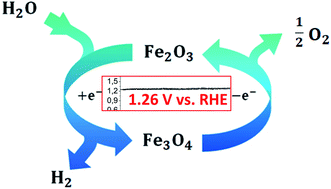Water splitting mediated by an electrocatalytically driven cyclic process involving iron oxide species†‡
Abstract
For a good reason, water splitting is the most pioneering energy storage technology. However, particularly water electrolysis still has a shadow existence compared to currently used methods for mass production of hydrogen. All known materials currently exploited as anodes for electrocatalytically initiated water-splitting suffer from high overpotentials and substantial mass loss during long term operation in acidic media. Low electrode stability affects operating and maintenance costs and together with high overpotentials directly lowers the overall efficiency of electrocatalytically driven splitting of water. In circumventing these problems, scientists and engineers are currently modifying electrode materials. We chose a completely different path and modified the electrolyte. An electrolysis set up, that consists of a Ni42 stainless steel anode and of hematite which is suspended in high concentration in sulfuric acid and acts as the electrolyte, exhibits oxygen evolution electrocatalysis at extremely low potential (1.26 V vs. RHE; 0.5 M H2SO4, j = 30 mA cm−2). If implemented in a suitable electrolyzer, an ultralow cell voltage of 1.6 V and an almost quantitative charge to oxygen + hydrogen conversion rate can be achieved. Remarkably, the negligible mass loss of the anode which consists exclusively of non-platinum group metals (non-PGM) during 100 h of operation. Experiments aimed at clarifying the mechanism suggest that Fe2O3 is converted to a Fe(II)/Fe(III) oxide species on the cathode which is then reconverted to Fe2O3 upon release of molecular oxygen when touching the anode. As a result, the oxygen-evolving centers are likely to be on the oxide particles rather than on the electrode. This proposed mechanism would explain the low potential of the OER electrode (+1.26 V vs. RHE at j = 30 mA cm−2) that could not be explained convincingly by an assumed direct oxidation of water molecules.



 Please wait while we load your content...
Please wait while we load your content...